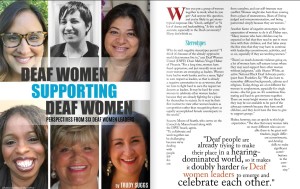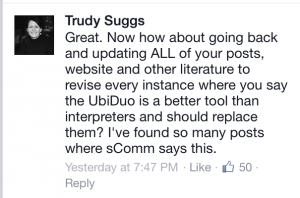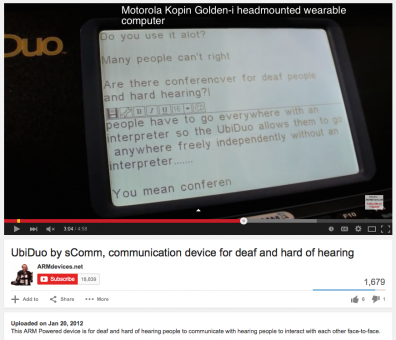This article originally appeared in Get a Z Life Magazine.
 When you put a group of women together to work, what do you get? Ask anyone this question, and you’re likely to get stereotypical responses like, “Oooh, catfight!” or “A lot of drama and backstabbing.” Is this really accurate, especially in the Deaf community? Many don’t think so.
When you put a group of women together to work, what do you get? Ask anyone this question, and you’re likely to get stereotypical responses like, “Oooh, catfight!” or “A lot of drama and backstabbing.” Is this really accurate, especially in the Deaf community? Many don’t think so.
Stereotypes
Why do such negative stereotypes persist? “I think it’s because of the already-oppressive world that women live in,” says Deaf Women United (DWU) Chair Melissa Yingst Huber of Phoenix. “For a long time, women have faced oppression, and just recently more and more women are emerging as leaders. Women have had to work harder, and in a sense, ‘fight’ to earn respect as leaders, so that is already a negative connotation in us as women, that we have to fight hard to earn the respect we deserve as leaders. It may be hard for some women to celebrate other women leaders because they are already fighting for a place for themselves in society. So it may be their first instinct to view other women leaders as competition rather than recognizing them as equally accomplished female counterparts in the world.”
Socorro Moore of Seattle, who serves on the Council de Manos board along with the DWU board, agrees. “To collaborate and work together can be challenging because we’re dealing with people different from ourselves, and our self-interests may conflict. Women might also have fears coming from a place of unawareness, [fears of] being judged and miscommunication, and being patronized simply because they are women.”
Another factor of negative stereotypes is the expectation of women to do it all. Huber says, “Many women who have children may be expected or feel that they need to put in more time with their children, and that takes away the free time that they may have to continue with leadership commitments, activities, and so on, especially if they are working women.”
“There’s so much domestic violence going on, a lot of women have self-esteem issues where they may need support from other women without judgment,” adds Sharon White, an active National Black Deaf Advocate participant from Frankfort, Ky. “We also have to remember different backgrounds, cultures and religions. Today, things are a lot different for women in employment, especially for single moms—the list goes on. It’s sometimes frustrating and hard to get everyone together. There are many bright women out there but they may be not available to be part of the advocacy network because they have small children, and they don’t have the time to give to support groups.”
Huber, however, sees an upside to this high expectation. “The idea that many women take on many different roles can enable them to be great multitaskers, juggle different commitments, and develop skills to make significant contributions to the community.”
Lack of Support and Role Models
Another challenge is the lack of support and role models, Huber says. “In the Deaf world, where the crab theory is already imminent, that’s a double negative for Deaf women. Deaf people are already trying to make their place in a hearing-dominated world, so it makes it doubly harder for Deaf women leaders to emerge and celebrate each other.”
“I think healthy models are lacking because many of us did not have other women to look up to while growing up,” Marilyn Jean Smith of Seattle says. Smith founded the acclaimed Abused Deaf Women Advocacy Services (ADWAS) organization and has served on numerous boards, including DWU and the National Association of the Deaf. She continues, “I personally had to unlearn a lot of things, move away from the hierarchal model and go with a consensus model, which I think respects everyone’s thoughts (or tries to). Our models have been traditional male ones, which is, for the most part, about power and control.”
Huber echoes this perspective. “It has often been said that women are too emotional and sensitive. However, I feel that very element makes women great leaders. Being emotionally in tune enables women to connect with others, be more in tune with others’ emotions, understand each other more, gauge interest and reactions from other people.”
She points out that the availability of Deaf women as role models in her upbringing helped her become the confident, happy woman she is today. “I’ve always loved being a Deaf woman. My pride of being a strong Deaf woman probably comes from the fact that I had a Deaf mother who was a strong woman, never afraid to share her thoughts, and that was instilled in me at a very young age. I also had wonderful Deaf female role models growing up. That sense of pride only got stronger as I grew older.”
The Deaf community is close-knit in nature, so when the crab theory is in full force, that can become difficult to address, Smith says. “I think we go quiet most of the time when we see someone sabotaging the efforts of another or don’t confront women who tell stories about others that may not be true. Our community is certainly small and in an effort to get along with everyone, however superficial it is, this can mean we sometimes keep quiet to not rock the boat.”
Sofia Seitchik, of Global Deaf Women, says, “This pulling-down of each other takes place because of people’s mindsets and their upbringings. Many don’t realize what their beliefs are as Deaf people, which are often developed from oppression.” She continues, “They need to reexamine themselves and ask themselves questions like, ‘Is there anything I can do to shift my mindset and beliefs as a Deaf woman, to believe that we are intelligent and as capable as any other person?’ This will help them open their hearts and this can be a very powerful self-mirror. Only then can they really support other women, such as Deaf business owners.”
Deaf Business Owners
Jasmine Garcia-Freeland, who owns All That Jazz and lives in Bozeman, Mont., sees this pulling-down often. “As a second-year business owner who is a Deaf woman, I think a lot of the negativity is based on mentality.” She cites a pattern among many Deaf women who refuse to support certain Deaf businesswomen simply because of personal conflicts, rather than looking at the bigger picture of the Deaf ecosystem. “To me, it doesn’t matter if I like that person or not. It’s important that we always support each other, encourage each other, and strive for a stronger Deaf business community so that our reach can extend to the hearing community, too.”
Seitchik is a successful business and life coach working with Deaf women entrepreneurs. “In the past few years we’ve seen some of the fastest-growing numbers of Deaf-owned and woman-owned businesses, but not many of them survive. This creates unique stressors, because so many eyes are on the owners, waiting to see if they fail. There exists a norm among the Deaf community that they will wait to see if a business makes it or not before they support.” As a result, Seitchik says, deaf businesswomen have to invest time and energy in educating the community on their businesses, rather than focusing on the businesses themselves.
Seitchik also receives the same questions repeatedly in her coaching: “I get asked over and over again, ‘Will I be successful in my business? Will Deaf people support me? Do you think I can do it?’ I see so much fear in their eyes, and this pains me because this is the mindset that has been in place for many years. Most deaf people prefer to invest in hearing businesses because they mistakenly believe that hearing people know more. This is even more true for deaf women business owners, and it’s tiring and demoralizing.”
Strategies for Support
Moore believes the solution to removal of negativity can be found in ourselves. “We each have to get out of our way to help others reach their goals. This goes beyond concern for yourself and your own advancement. Don’t panic when others are happy and improving—envy, jealousy, and bitterness are a waste of time, and it’s not a great place to feel insecurity.”
Smith agrees wholeheartedly. “I have my limits with negative people. There is only so much I can do and then I need to walk away or minimize our encounters. One thing I know for sure: always respond in a positive way to negativity. It is draining work but it has to happen or you risk getting sucked in.” She suggests writing about your experiences, and having dialogue by being vulnerable and being open. She often posts her thoughts on social media, saying, “I’m amazed at how many people validate some things I post on Facebook with responses like, ‘Whew, I’m not alone. I thought I was the only one.’ We need to praise other women not just to their faces but also to others. Cherish their gifts, as you want them to cherish yours. Be a role model.”
White says, “Trying to work together and trying to find a common ground is always important. It’s best to take a negative situation and try to see the positive of it and work with that.” She adds, “We need to start offering our experiences in exchange for helping out with peer groups for women to help become more independent as well as boosting their self-esteem.” Sharing experiences to bond with others is another way women can support each other, she believes. “Provide support for them. Let them know there are resources out there. Be honest and open-minded, and provide clear communication so that things can be understood rather than misunderstood. Basically, treat deaf women the way you wish to be treated as a human being, not because we are deaf.”
Celebrating each person’s accomplishments is another step, Huber says. “Each woman has a unique story and has so much to contribute, and it’s so important to celebrate and recognize what each woman can contribute, whether big or small. When women are recognized and celebrated, this inspires other women, creating a ripple effect.”
Although there are many who continue to believe in traditional roles and expectations for women, Huber has hope. “The optimist in me has already seen so much positive change in today’s society where people are becoming more accepting and aware of everyone’s differences, respecting everyone’s backgrounds. There are only more good things to come, which will include more acceptance, celebration, and respect for women. Not only the concept of womanhood, but also the full picture of each woman, all the different layers in each woman, and the different intersectionalities of each.”
Garcia-Freeland adds, “It’s so important to socialize with women from all walks of life, because this is the reality of the world. It’s diverse, and I want to work well with others. I can accomplish this because I value each person’s experiences and stories, regardless of whether we have mutual friends or not.”
“I am aware that we Deaf women may have to work harder and prove ourselves, but that’s okay with me, because I know that we Deaf women are fully capable of accomplishing many wonderful things. I would not change a thing, especially with the plethora of Deaf female organizations out there and all the opportunities for Deaf women out there,” Huber says. “There’s always magic when you put together a group of women, because they’re able to influence each other and inspire each other in positive ways.”


